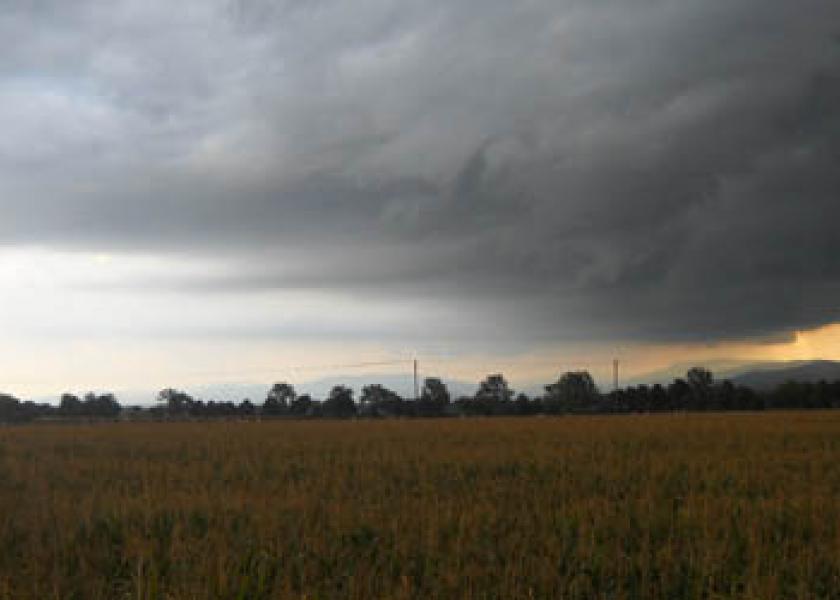Weather Drives 2013 Outlook for Grain, Meat

A recent visit to Amarillo, Texas, put the drought situation into perspective for Pro Farmer editor Chip Flory. With corn planting underway, he says, farmers already were turning on the pivots just to get the crop to emerge from the ground. They had received just 4" of rain in the previous 30 months.
"We’re looking at historic situations, whether it be trends in prices or trends in yields," says Flory, who presented his 2013 grain outlook on Tuesday during a webinar hosted jointly by Farm Journal and Watt Ag Media. "The drought that we’ve got in the central and western Corn Belt and the central and southern plains is a tough one."
Both Flory and Tom Elam, president of FarmEcon LLC, say uncertainty over weather conditions will result in volatile grain prices. They spoke ahead of the prospective plantings and quarterly grain stocks reports due out Thursday.
"It makes hedging and cash contracting a nightmare," Elam says. While corn prices could climb to $10/bu. under a drought scenario comparable to that of 2012 and an average national yield of 125 bu./acre, that price wouldn’t last long, he adds.
"That’s just too much stress on the system," Elam says.
The potential range for old- and new-crop corn prices this year is $4/bu. to $8/bu., Flory says. He indicated he is hesitant to say an excellent growing season is developing simply because planting isn’t getting underway as quickly as it might have.
Uncertainty surrounding the timing of planting, summer weather and other factors makes it difficult to pin down prices, Elam says. In particular, the "loaded gun" that is the western Corn Belt drought is an important consideration.
As for the exports forecast, Flory says they are the lowest he’s seen in a long time. The drought "erased 40 years, or four decades’, worth of work to build up the export market for U.S. corn," he says, and it will time to get back to past levels.
At the same time, exports have helped sustain the meat and poultry production system in the last three years, Elam says. Livestock and poultry feeders will continue to be challenged by high and ever-changing feed costs. Meanwhile, nine poultry companies have declared bankruptcy since 2008, and two more have undergone forced sales. Two more meat plants shut down recently. Increasing demand for ethanol under the Renewable Fuel Standard will limit corn availability further in the future.
A slight increase in poultry production is expected to offset a slight decline in beef production in 2013, Elam says. That’s miraculous given the cost-per-pound increase producers have experienced, coupled with an ongoing decline in meat consumption per capita.
Other points of interest from the webinar:
- Soft red winter wheat is in good shape, likely resulting in an early supply of feed from the Eastern Corn Belt.
- About 9.5 million acres of cotton likely will be planted this year in the U.S. That’s below USDA projections of 10 million acres. The departure from cotton acres will leave between 2.5 million and 3 million open for other crops, primarily corn. Southern corn will be harvested earlier than corn elsewhere, and that supply will bridge the gap from tight old-crop supplies to the new-crop situation.
- Growing opportunities will expand if soil moisture conditions ease over Iowa, most of Minnesota and down into Missouri and South Dakota.
- China continues to buy old-crop U.S. soybeans because of loading delays in South American harbors. The number of waiting vessels surpassed 100 last week, and the total wait time is between 45 and 50 days from the time a vessel arrives for loading to the time it departs with soybeans.
- Average growing conditions for corn would project a national average yield of 150 bu./acre, Flory says. That’s up from the 123 bu./acre national average yield for the 2012-13 drought year.
- Food affordability is declining amid higher prices and slow economic growth. The economy has been growing significantly slower than it generally does in a post-recession recovery, Elam says.
- Corn prices do matter for food costs. ""We can see that when corn prices depart from their long-term trend that food costs in the economy depart in the same direction," he says, noting that the trend will continue this year and in 2014.
- The base crop forecast is for some limited room for protein production expansion, a rebound in corn exports and improved protein production profitability, Elam says. The base projection minus 15 bu./acre of corn would result in higher corn production than in 2012 but a sharply lower feed supply, much higher feed costs and price pressures, and $8.50/bu. corn for a good piece of the year. Additionally, more protein and ethanol companies likely would shut down. A brighter scenario—the base projection plus 15 bu./acre of corn—could result in a significant rebound in feed use and exports and expanded protein production in 2014.
For More Information
AgWeb will continue its pre-report coverage of the March 28 Prospective Plantings report. Here are a few items to read now:
Prospective Plantings Preview: 10 Key States
Gulke’s Pre-Game Picks for the Planting Report
Preview of the Quarterly Stocks and Prospective Plantings Reports
See current market prices in AgWeb's Market Center







